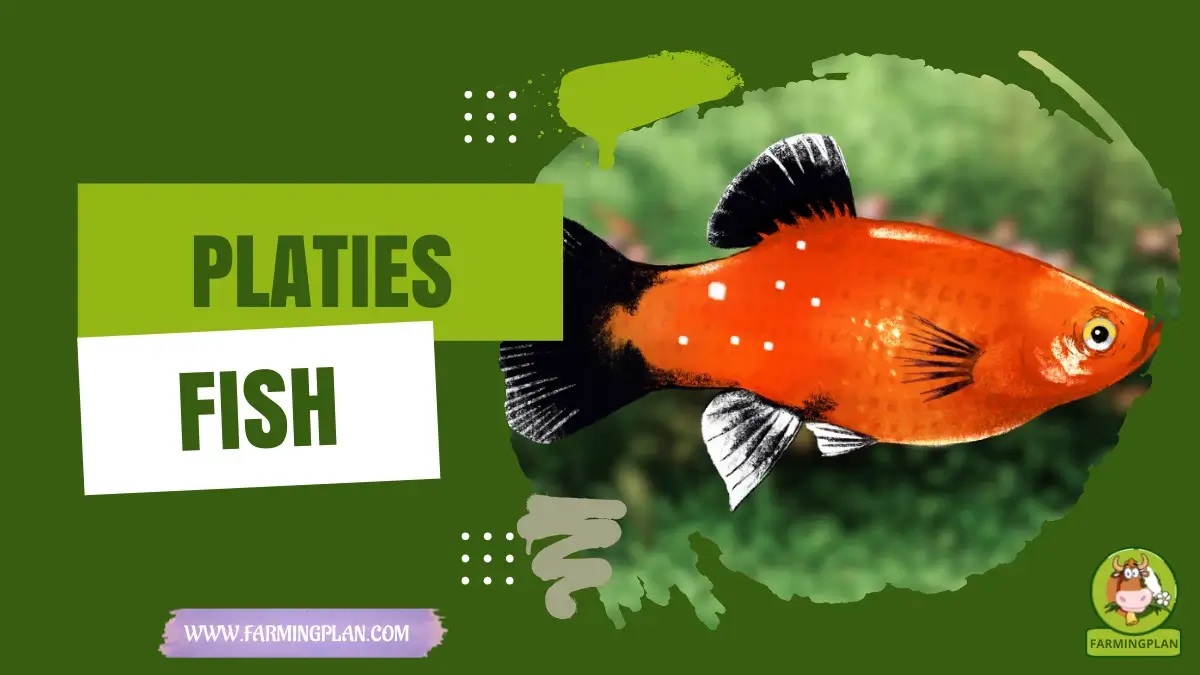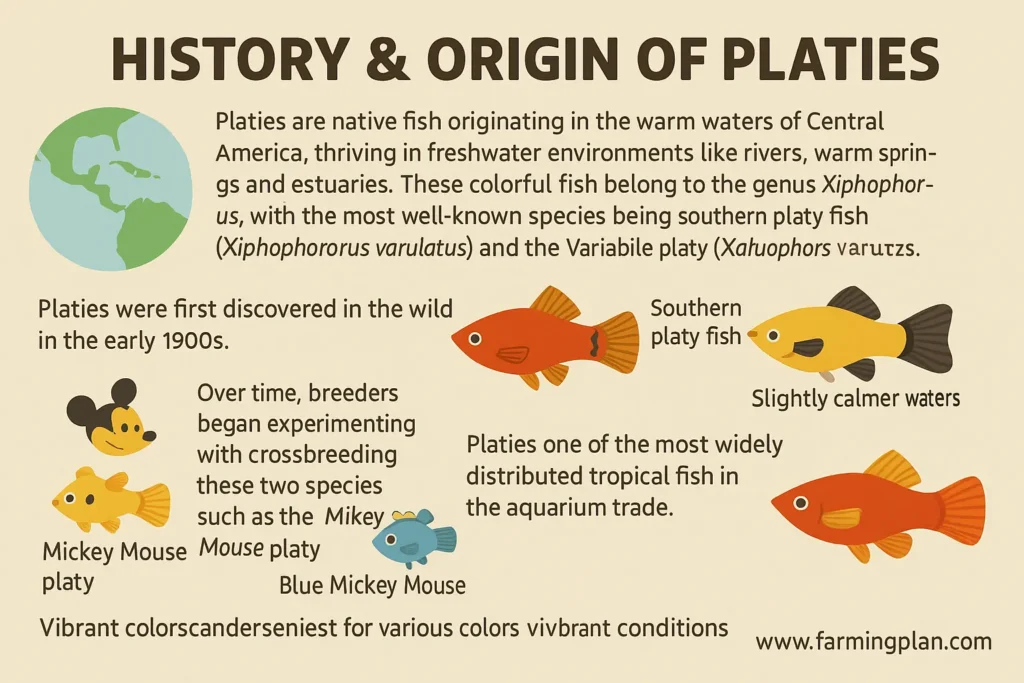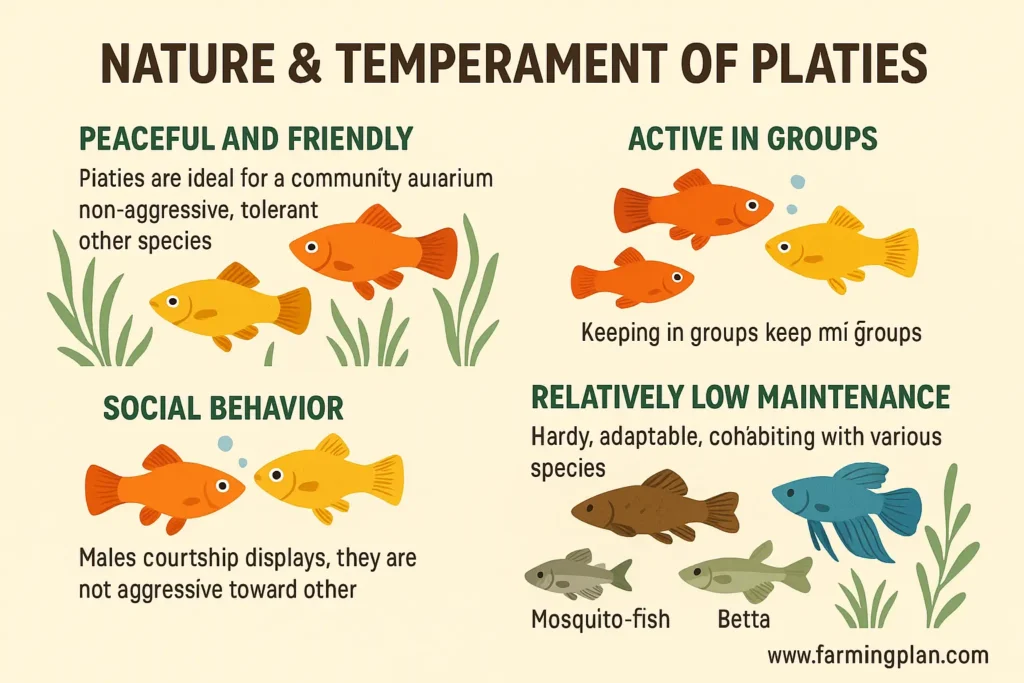Platies are among the most popular freshwater aquarium fish—for good reason. These vibrant, peaceful, hardy fish are perfect for beginners and experienced aquarists. Native to Central America, platies thrive in a wide range of water conditions and come in stunning colors and patterns, including the iconic Mickey Mouse platy. Whether you want to add a splash of color to your tank or build a thriving community aquarium, platies are an excellent fish species choice. This guide explores everything from their history and care requirements to expert tips for creating the perfect environment for your platies to flourish.

History & Origin of Platies
Platies are native fish originating in the warm waters of Central America and Mexico, thriving in freshwater environments like rivers, warm springs, and estuaries. These colorful fish belong to the genus Xiphophorus, with the most well-known species being the southern platy fish (Xiphophorus maculatus) and the Variators platy (Xiphophorus variators). The southern platy fish is typically found in the warmer areas, while the Variators platy prefers slightly calmer waters.

Platies were first discovered in the wild in the early 1900s. Over time, breeders began experimenting with crossbreeding these two species, which led to the development of many colorful variations and hybrids, such as the Mickey Mouse platy and the Blue Mickey Mouse. These fish gained popularity due to their hardiness, ability to adapt to various water conditions, and vibrant color patterns, making them a favorite among hobbyists and fish owners.
Unlike some species in specific regions, platies have become one of the most widely distributed tropical fish in the aquarium trade. Their peaceful nature and low-maintenance care have made them a staple in community tanks, and their history reflects a journey from their native habitats in Central America and Mexico to homes and aquariums worldwide.
Characteristics of Platies
Platies are small, colorful fish easily recognized for their vibrant appearance and peaceful nature. Typically growing to about 2.5 to 3 inches in length, these fish are ideal for both beginner and experienced aquarium enthusiasts. They are hardy and adaptable and can thrive in a wide range of water conditions, making them perfect for various tank setups.
One of the most exciting aspects of platies is their wide variety of colors and patterns. You can find them in shades of red, orange, yellow, and blue, with some species exhibiting beautiful patterns like the Mickey Mouse platy. The Mickey Mouse platy, with its unique shape and black markings resembling Mickey Mouse’s silhouette on its tail, is particularly popular among aquarium keepers. Other variants include the Blue Mickey Mouse and Gold Mickey Mouse, each with its stunning color palette.
Regarding physical features, female platies tend to be larger and rounder, especially when carrying baby fish, while males are generally more petite and slender. Male platies also possess a gonopodium, a modified fin used during mating. This difference in size and shape makes it easy to distinguish between the sexes.
These fish are social creatures and enjoy the company of their own kind and other peaceful species. They do well in community tanks and can coexist with species such as betta fish, bristle-nose plecos, and mosquito fish. Their calm demeanor and colorful appearance make them a favorite for anyone looking to add a splash of color and personality to their aquarium.
Nature & Temperament of Platies
Platies are known for their peaceful and friendly nature, making them ideal for a community aquarium. These fish are not aggressive and tend to get along well with most other species, provided they are not overly territorial or aggressive. This makes platies an excellent choice for first-time fish owners or anyone looking to add vibrant color without worrying about compatibility issues.

They are active swimmers, often found near the middle or top of the tank, and can be pretty curious about their surroundings. This fish thrive in groups, so keeping at least three to six of them together is best. While they can live alone, having a group allows them to exhibit natural behaviors and feel more secure in their environment.
One interesting characteristic of platies is their social structure. You’ll see males performing courtship displays to attract females when kept in a group. However, this fish are generally not aggressive toward each other, even during mating. This makes them excellent companions in a peaceful community tank, where they can cohabit with various species, such as bristle nose plecos, mosquito fish, and even betta fish, as long as the bettas aren’t overly aggressive.
Platies also have relatively low maintenance in terms of temperament. They do well in tanks with stable water conditions and aren’t particularly sensitive to small environmental fluctuations, making them adaptable to different water parameters. Their calm disposition, friendly nature, and ease of care make platies a top choice for aquarium enthusiasts, hobbyists, and fish owners looking for a lively yet non-disruptive addition to their tank.
Read More: Platies: Popular with a Variety of Colored Platies Fish
Food & Diet
Platies are omnivores, meaning they eat plant- and animal-based foods. This makes feeding them quite flexible and straightforward, as they will accept a variety of commercial fish pellets, flaked foods, and even live foods like blood worms and brine shrimp. These foods provide essential nutrients that support their overall health and vibrant colors.
For a balanced diet, this fish should be a mix of high-quality fish flakes and occasional live or frozen foods. A good feeding schedule involves offering food once or twice a day, with portions that can be consumed within a few minutes. Be cautious of overfeeding plants, leading to poor water quality and health problems such as bloating or obesity.
In addition to protein-rich foods, platies benefit from vegetable matter. To meet their fiber needs, you can offer blanched vegetables such as spinach, zucchini, and peas or plant-based flakes. Adding aquarium plants to the tank can also help platies nibble on greenery between meals, mimicking their natural habitat.
Platies thrive in tanks with clean water, and it’s essential to monitor water quality regularly, as excess food can pollute the tank. Automatic fish food feeders are an excellent tool for ensuring consistent feeding, especially if you are away for a few days, but remember to adjust them to avoid overfeeding.
Usage & Purpose of Platies
Platies are used for a number of purposes in domestic aquariums and large-scale aquaculture, and as such, they are a versatile and widely used fish among fish keepers. Platies are mostly kept as domestic pets in home aquariums because of their bright colors, friendly nature, and simplicity of care. Their peaceful nature makes them an excellent choice for a community tank, where they can coexist with other non-aggressive species like bristle-nose plecos, mosquito fish, and betta fish.
In addition to their role as decorative fish, platies are also known for their live-bearing reproduction. This means they give birth to fully formed, free-swimming young, making them a fascinating species for aquarium enthusiasts interested in breeding. Female platies can give birth to anywhere from 10 to 30 fry at a time, and with the proper care, you can see multiple generations of platies growing in your tank. This makes them an excellent choice for hobbyists who enjoy breeding fish and watching their babies grow.
Platies are also used in commercial settings, such as fish stores and aquatic pet shops, where they are bred and sold in large numbers. Their ability to adapt to a wide range of water conditions and their high reproductive rates make them a staple in the fish trade. In addition, some fish farmers use platies to control mosquito populations, as they can help manage larvae in tropical environments.
Beyond their use as pets and breeding specimens, this fish can also serve an educational purpose. They are often used in school aquariums or science classes due to their simple care requirements and the opportunity they provide for students to learn about aquatic life cycles and fish behavior.
Read More: Mollies Fish: Black and Speckled Yellow Colored Fish
Special Features
Platies are a remarkable fish species that stand out due to their unique characteristics and special features, making them a favorite among aquarium hobbyists. For example, the Mickey Mouse platy, a very popular one, has a distinctive black “Mickey Mouse” form on its tail, which makes it so popular.
Another unique characteristic is their live-bearing reproduction. Platies are not like most other fish that lay eggs; instead, they give birth to live offspring, making them quite simple for hobbyists to breed. For example, the popular Mickey Mouse platy has a distinctive black “Mickey Mouse” pattern on its tail, adding to its appeal.
Another special feature is their live-bearing reproduction. Unlike many other fish species, platies give birth to live young instead of laying eggs, which makes breeding relatively easy for hobbyists. Female platies can produce numerous offspring at a time, typically between 10 to 30 baby fish (called fry), and their rapid growth can be pretty fascinating to observe.
Platies are also known for being hardy fish. They are low-maintenance and adaptable to a wide range of water conditions, including variations in temperature and pH. This makes them an excellent choice for beginner fish owners and a peaceful community fish for larger aquariums.
Their ability to thrive in tropical environments and their general resilience make them suitable for different aquarium setups. Whether it’s a planted tank with lots of greenery or artificial plants, plants are adaptable to various environments. Additionally, they are comfortable in warmer and alkaline waters, creating the perfect environment for them and their fellow tank mates.
platies are naturally peaceful, making them an ideal addition to any community tank. They do not exhibit aggressive behaviors, and their calm temperament means they won’t disrupt other fish, including delicate species like Siamese fighting fish or betta fish.
Read More: Guppy Fish: The Most Beautiful and Reproductive Species
Health Issues & Prevention for Platies
Like all fish, platies can be susceptible to specific health issues, but these problems can often be prevented or treated with proper care. Maintaining the right water quality, temperature, and diet is key to keeping your platies healthy. You can avoid common health issues by keeping your environment clean and stable.
Common Diseases
- Ich (White Spot Disease): One of the most common diseases in aquarium fish, Ich is caused by a parasite that forms small white spots on the fish’s body. It can be triggered by poor water quality or stress. If you notice white spots or behavioral changes like scratching isolation or fast gill movement, isolate the infected fish and treat the tank with an anti-parasitic medication.
- Fin Rot: This bacterial infection causes the fish’s fins to look ragged or decayed. It is caused by injury, poor water quality, or stress. Treat fin rot by improving the quality of water and applying an antibacterial treatment. It’s vital to remove all decaying tissue from the tank and ensure that the aquarium filter is operational.
- Dropsy: It is a condition with puffy tummies and bulging eyes, usually due to failure of organs or infection. While it is serious, it can often be prevented by maintaining proper water quality and a balanced diet.
- Swim Bladder Disease: affects the fish’s ability to swim properly, causing it to float at the surface or struggle to stay at the bottom. It can result from overfeeding or poor water conditions. Avoid overfeeding and ensure that the fish do not consume too much food at once. You can treat it by fasting the fish and providing a balanced diet.
Preventive Measures
- Regular Water Changes: To avoid most health problems, keep your tank water clean by performing regular water changes (about 20% every 2-3 weeks). This helps maintain the correct water parameters and reduces the buildup of harmful toxins.
- Maintain Ideal Water Parameters: Platies prefer alkaline water with a temperature range of 72-82°F (22-28°C). Regularly check the pH, hardness (dGH), and temperature to ensure suitable water conditions.
- Good Nutrition: Feed your plants a well-balanced diet with high-quality pellets, live foods like blood worms, and plenty of plant matter. This will boost their immune system and overall health.
- Avoid Overcrowding: Overcrowding can lead to poor water quality and stress, which increases the likelihood of disease. Ensure your tank is not too small for your fish and that they have enough space to swim.
- Observe Behavior: Always monitor your pets for signs of illness. Changes in swimming behavior, eating habits, or appearance may be the first indicators of a health problem.
- Quarantine New Fish: To prevent the introduction of new diseases to your established tank, always quarantine new platies (or any new fish) for at least two weeks before adding them to your main tank.
Adhering to proper care and preventive measures can ensure that your platies stay healthy and vibrant, providing a long and joyful life in your aquarium.
“Platies Prove That Small Fish Can Bring Big Joy—bright Colors, Peaceful Vibes, And Zero Drama!”
Step-by-Step Guide to Caring for Platies
It is easy to take care of platies, and they are an excellent option for both beginner fish owners and experienced enthusiasts. By just following the steps above, you can make your platies thrive in their tank and live a healthy life.
Setting Up the Aquarium
- Tank Size: A small school of platies can be kept in a 10-gallon tank, but the larger tank will offer a chance for healthier fish and development. A larger tank gives the fish more space to swim and reduces stress.
- Aquarium Filter: Ensure the tank has a good filter (canister or carbon filter) to maintain clean water. This helps remove toxins and ensures a healthy environment for your plants.
- Aquarium Decor: Platies love to swim around plants, so adding aquarium plants like java fern or anoias will enhance their living environment. Be sure to include decorations like rocks and caves, which provide hiding spots and help reduce stress.
Maintain Optimal Water Conditions
- Temperature: Keep the water temperature between 72-82°F (22-28°C), as platies thrive in warmer waters. A thermometer will help you monitor the temperature, and a submersible heater will ensure consistency.
- Water pH and Hardness: Platies prefer slightly alkaline water, with a pH between 7.0-8.0. Ensure the water hardness (DGH) is around 10-20 for the healthiest conditions.
- Regular Water Changes: Perform regular water changes (about 20% every 2-3 weeks) to keep the water clean and toxins-free. Use a dechlorinate if you’re using tap water.
Feeding Your Platies
- Diet: Platies are omnivores, so feed them a balanced diet. Offer a mix of high-quality fish pellets, flakes, live foods like blood worms, and vegetable matter like spirulina or blanched spinach.
- Feeding Schedule: Feed your platies twice daily, providing only what they can eat in 2-3 minutes to avoid overfeeding. Throw away remaining food to prevent water contamination.
Observe Fish Health
- Watch for Signs of Illness: Inspect your plates consistently for any sign of disease, whether in behavior, appetite, or physical changes. Treat any illness all at once to prevent spreading.
- Quarantine New Fish: If introducing new fish, always quarantine them for a minimum of two weeks to avoid introducing diseases to your established tank.
Breeding Platies
- Breeding Setup: Female platies can give birth to up to 30 fry at a time. To ensure healthy births, you can set up a breeding box inside the tank or move the pregnant female to a separate breeding tank to protect the fry.
- Baby Fish Care: After birth, platy fry can be fed infusoria or baby brine shrimp. Ensure they have a safe space free from adult platies, as the adults may eat the fry if given the chance.
Regular Tank Maintenance
- Clean the Tank: In addition to water changes, clean the substrate, filter, and decorations regularly to prevent debris and waste buildup.
- Check for Overcrowding: Make sure the tank doesn’t become overcrowded, as this can lead to water quality issues and stress. One platy per 2-3 gallons of water is a good rule of thumb.
Following these steps will create a perfect environment for your platies to thrive. These hardy fish are easy to care for, providing years of beauty and joy in your aquarium.
FAQ
What is the ideal tank size for platies?
A minimum of a 10-gallon tank is recommended for a small group of platies. However, a 20-gallon long tank is ideal, providing ample space for swimming and reducing territorial disputes among males.
How often should I feed my platies?
Feed platies 1–3 times daily, offering only as much as they can consume in a few minutes. A varied diet of high-quality pellets, live or frozen foods like bloodworms, and occasional vegetables ensures balanced nutrition.
How can I tell if my platy is pregnant?
Pregnant female platies exhibit a rounded belly and a dark gravid spot near the rear fin. Pregnancy lasts about 28 days, and females can give birth to 20–50 fry per brood.
What are common health issues in platies?
Platies may suffer from Ich, fin rot, dropsy, or swim bladder disease. Maintaining clean water, a balanced diet, and a stress-free environment helps prevent these issues.
Are platies compatible with other fish?
Yes, platies are peaceful community fish. They coexist well with species like guppies, tetras, and corydoras catfish. Avoid housing them with aggressive fish such as betta fish.
Conclusion
Platies are hardy, peaceful, and vibrant livebearers, making them ideal for both novice and experienced aquarists. With proper care—including a suitable tank size, consistent feeding, and attention to water quality—they thrive in community aquariums. Their ease of breeding and adaptability to various environments further enhance their appeal. By providing a balanced diet, monitoring health, and ensuring a stress-free habitat, platies can live long, healthy lives, adding color and activity to your aquarium.
